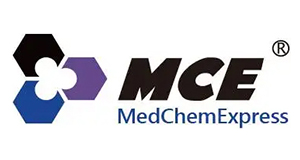Amphotericin B-13C6
Amphotericin B-13C6
Artikelnummer
MEXHY-B0221S-1
Verpackungseinheit
1 mg
Hersteller
MedChemExpress
Verfügbarkeit:
wird geladen...
Preis wird geladen...
Product Description: Amphotericin B-13C6 is 13C labeled Amphotericin B (HY-B0221). Amphotericin B is a polyene antifungal agent against a wide variety of fungal pathogens. It binds irreversibly to ergosterol, resulting in disruption of membrane integrity and ultimately cell death.
Applications: Cancer-programmed cell death
Formula: C41 13C6H73NO17
References: [1]Sau K, et al. The antifungal drug amphotericin B promotes inflammatory cytokine release by a Toll-like receptor- and CD14-dependent mechanism. J Biol Chem. 2003 Sep 26;278(39):37561-8. Epub 2003 Jul 14./[2]Barwicz J, et al. The effect of aggregation state of amphotericin-B on its interactions with cholesterol- or ergosterol-containing phosphatidylcholine monolayers. Chem Phys Lipids. 1997 Feb 28;85(2):145-55./[3]Ramos H, et al. Amphotericin B kills unicellular leishmanias by forming aqueous pores permeable to small cations and anions. J Membr Biol. 1996 Jul;152(1):65-75./[4]Demaimay R, et al. Pharmacological studies of a new derivative of amphotericin B, MS-8209, in mouse and hamster scrapie. J Gen Virol. 1994 Sep;75 (Pt 9):2499-503./[5]Adams ML, et al. Amphotericin B encapsulated in micelles based on poly(ethylene oxide)-block-poly(L-amino acid) derivatives exerts reduced in vitro hemolysis but maintains potent in vivo antifungal activity. Biomacromolecules. 2003 May-Jun;4(3):750-7./[6]Russak EM, et al. Impact of Deuterium Substitution on the Pharmacokinetics of Pharmaceuticals. Ann Pharmacother. 2019 Feb;53(2):211-216.
Molecular Weight: 930.03
Research Area: Cancer
Solubility: 10 mM in DMSO
Target: Antibiotic;Bacterial;Fungal;Isotope-Labeled Compounds;Parasite
Applications: Cancer-programmed cell death
Formula: C41 13C6H73NO17
References: [1]Sau K, et al. The antifungal drug amphotericin B promotes inflammatory cytokine release by a Toll-like receptor- and CD14-dependent mechanism. J Biol Chem. 2003 Sep 26;278(39):37561-8. Epub 2003 Jul 14./[2]Barwicz J, et al. The effect of aggregation state of amphotericin-B on its interactions with cholesterol- or ergosterol-containing phosphatidylcholine monolayers. Chem Phys Lipids. 1997 Feb 28;85(2):145-55./[3]Ramos H, et al. Amphotericin B kills unicellular leishmanias by forming aqueous pores permeable to small cations and anions. J Membr Biol. 1996 Jul;152(1):65-75./[4]Demaimay R, et al. Pharmacological studies of a new derivative of amphotericin B, MS-8209, in mouse and hamster scrapie. J Gen Virol. 1994 Sep;75 (Pt 9):2499-503./[5]Adams ML, et al. Amphotericin B encapsulated in micelles based on poly(ethylene oxide)-block-poly(L-amino acid) derivatives exerts reduced in vitro hemolysis but maintains potent in vivo antifungal activity. Biomacromolecules. 2003 May-Jun;4(3):750-7./[6]Russak EM, et al. Impact of Deuterium Substitution on the Pharmacokinetics of Pharmaceuticals. Ann Pharmacother. 2019 Feb;53(2):211-216.
Molecular Weight: 930.03
Research Area: Cancer
Solubility: 10 mM in DMSO
Target: Antibiotic;Bacterial;Fungal;Isotope-Labeled Compounds;Parasite
| Artikelnummer | MEXHY-B0221S-1 |
|---|---|
| Hersteller | MedChemExpress |
| Hersteller Artikelnummer | HY-B0221S-1 |
| Verpackungseinheit | 1 mg |
| Mengeneinheit | STK |
| Produktinformation (PDF) | Download |
| MSDS (PDF) |
|

 English
English







